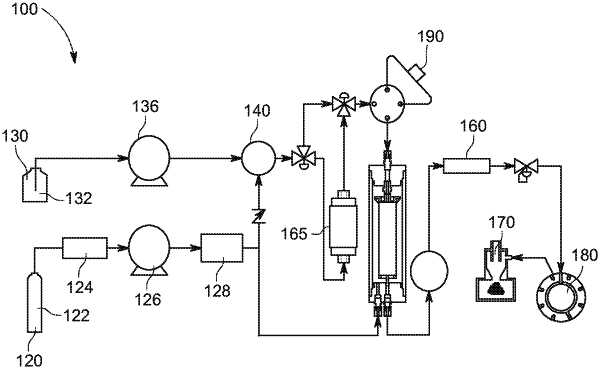| CPC F25B 25/005 (2013.01) [B01D 15/165 (2013.01); B01D 15/40 (2013.01); B04C 5/081 (2013.01); B04C 5/085 (2013.01); B04C 9/00 (2013.01); C07C 45/79 (2013.01); C07C 51/47 (2013.01); C07C 67/56 (2013.01); C07C 231/24 (2013.01); C09K 5/041 (2013.01); F25B 7/00 (2013.01); F25B 9/002 (2013.01); F25B 9/008 (2013.01); F25B 9/10 (2013.01); F25B 49/02 (2013.01); G01N 30/30 (2013.01); G01N 30/54 (2013.01); B04C 2009/004 (2013.01); C09K 2205/106 (2013.01); C09K 2205/13 (2013.01); C09K 2205/132 (2013.01); F25B 2600/2513 (2013.01); F25B 2700/21171 (2013.01); G01N 30/20 (2013.01); Y02P 20/54 (2015.11)] | 19 Claims |

|
1. A method of cooling via a circulator system utilizing the Joule-Thomson cooling effect of a fluid expanding through an expansion device located adjacent a pump head of a chiller pump to cool a refrigerant being pumped by the chiller pump, the method comprising:
(a) introducing the refrigerant into the circulatory system from a source container holding the refrigerant at ambient temperature, the system comprising an inlet portion, a pressurized portion and an expansion portion;
(b) flowing the refrigerant from the inlet portion, comprising the source container connected, via a circuit to the pressurized portion comprising a chiller pump;
(c) pumping into the pressurized portion of the system the refrigerant supplied from the inlet portion through the chiller pump with a pump head, the chiller pump pumping at a speed sufficient to keep the refrigerant in continuous circulation through the pressurized portion at a continuous pressure of between 500 psi and 10,000 psi;
(d) bringing the pressurized portion into fluid communication with a heat sink to allow heat to pass from a heated component external to the circulatory system, to the heat sink, and to the refrigerant circulating through the pressurized portion;
(e) expanding a fluid in the expansion portion of the system through orifices of an expansion device located adjacent to the pump head of the chiller pump, the expansion device cooling the expanding fluid by virtue of the Joule-Thomson effect, the cooled fluid then cooling the pump head that in turn cools the refrigerant flowing into the pressurized portion from the chiller pump to a temperature between −5° C. and −30° C.
|